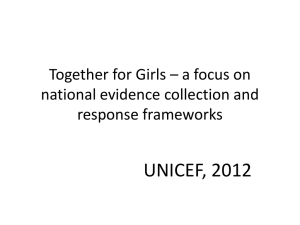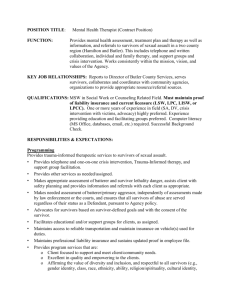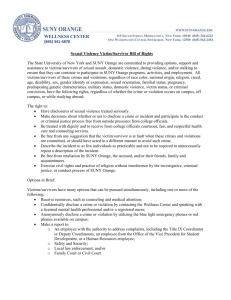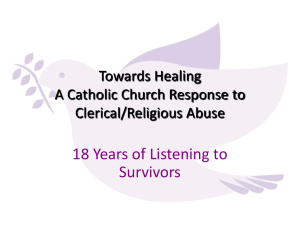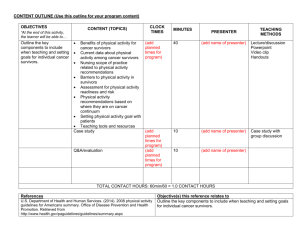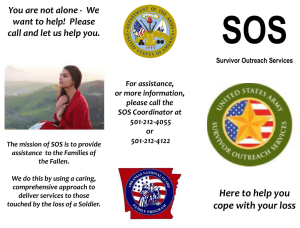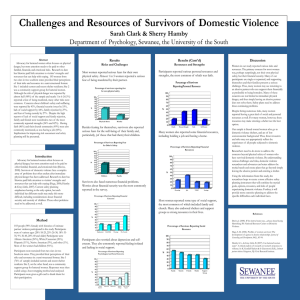English - GBVIMS
advertisement
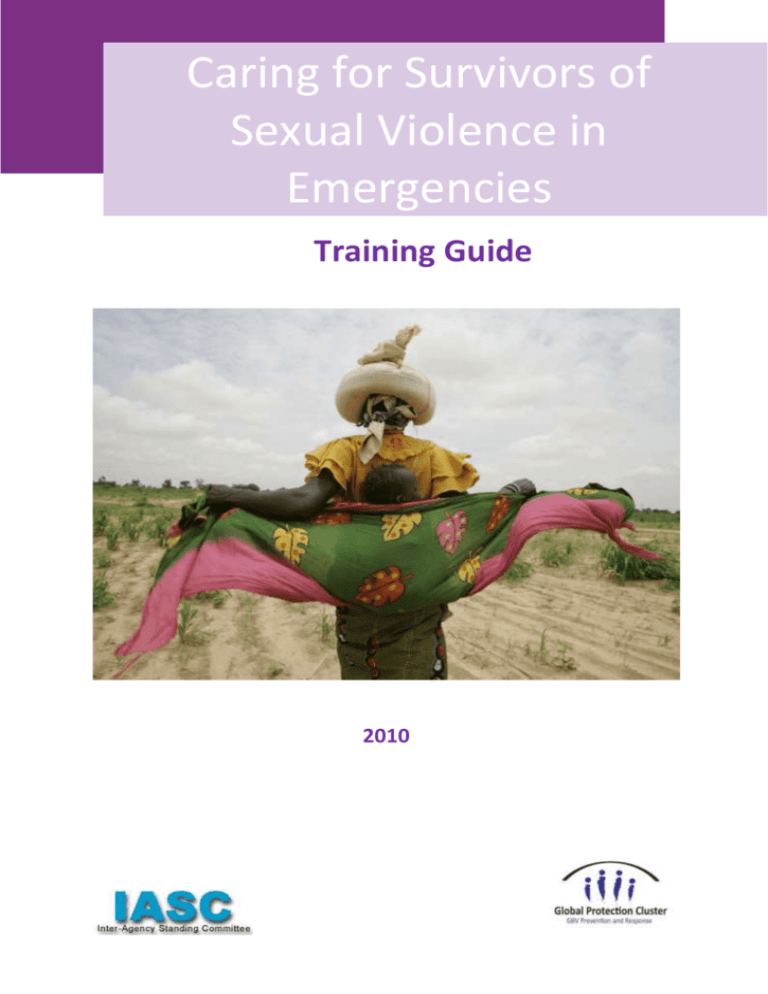
Caring for Survivors of Sexual Violence in Emergencies Training Guide Training Pack 2010 Caring For Survivors Training Guide Foreword The Caring for Survivors of Sexual Violence in Emergencies package is a product of the InterAgency Standing Committee (IASC) Sub-Working Group on Gender in Humanitarian Action with support from the Gender-based Violence Area of Responsibility (GBV AoR). Caring for Survivors was endorsed by the IASC Sub-Working Group on Gender in Humanitarian Action in November 2009. The IASC Principals converted the IASC Gender Task Force into a Sub-Working Group to support the strategy for integration of gender as a crosscutting issue into the Cluster Approach and into other elements of the humanitarian reform. The (GBV AoR) is responsible, under the global Protection Cluster Working Group, for ensuring a well-coordinated response to GBV in humanitarian emergencies. Co-led by UNICEF and UNFPA, the GBV AoR is committed to building local and global capacity to establish good quality, well-coordinated interventions to prevent and respond to GBV. This workshop package is one of a growing number of tools, guidance, and training materials produced by the IASC Sub-working Group on Gender in Humanitarian Action and the GBV AoR. The package is intended to provide technical support and guidance to practitioners and leaders working in field sites throughout the world. Financial support for the development of the package was provided by the European Commission’s Humanitarian Aid department (ECHO), AusAid, and the Austrian Government. UNICEF led the development of this training package, but the end product is the outcome of “true” interagency efforts by a number of individuals, including, but not limited to, Tami Pollak. An Michels, Tamar Renaud, Donna Gafney, Susie Nasr, Chen Reis, Claudia GarciaMoreno, Erin Kenny, Massimo Zucco, Maha Muna, Pamela Shifman, Henia Dakkak, Maria Caterina Ciampi, Emmanuelle Compingt, Jennifer Miquel, Janna Metzler and Mendy Marsh and agencies including, but not limited to, CARE, FAO, INEE, ICRC, IFRC, IMC, IOM, IRC, NRC, OCHA, OHCHR, Office RSG/IDPs, OSAGI, OXFAM, UNDAW, UNDESA, UNDP, UNFPA, UNHCR, UNICEF, UNIFEM, UNMAS, WFP, WHO, and the Women's Refugee Committee. Members of the IASC Sub-working Group on Gender in Humanitarian Action and the GBV AoR are working together to roll out the Caring for Survivors Training Pack in different regions and countries throughout the world. Requests for support are solicited by government, NGO and UN partners and from GBV coordination structures in cluster countries. The inter-agency training package “Caring for Survivors” was developed in an effort to provide multi-sectoral actors with the necessary survivor-centered skills and tools to improve referral systems and care and support to survivors of GBV in their communities. IASC Gender SWG / GBV AoR 2010 2 Caring For Survivors Training Guide The training pack is composed of 2 main modules: a general and psychosocial module and a medical module. Each module is divided into 2 manuals: one for participants and one for facilitators. In addition, for the medical modules, power point presentations are included in the training package to support the facilitation of these modules. This Training Pack can be used to develop multi-sectoral skills (e.g. health, psychosocial, legal/justice and security) and is designed for professional health care providers, as well as for members of the legal professionals, police, women’s groups and other concerned community members, such as community workers, teachers and religious workers. ∞∞∞∞ IASC Gender SWG / GBV AoR 2010 3 Caring For Survivors Training Guide CONTENTS FOREWORD ...................................................................................................................................... 2 WORKSHOP PURPOSES AND INTENDED OUTCOMES ........................................................................... 5 PARTICIPANTS ................................................................................................................................... 7 NOTES ABOUT THE TRAINING MANUAL PACKAGE............................................................................... 8 PREPARING FOR THE WORKSHOP ....................................................................................................... 8 VENUE AND SET UP 11 SCHEDULE AND AGENDA ........................................................................................................................... 12 DETAILED AGENDA 12 DETAILED FACILITATION GUIDE .................................................................................................................. 16 ROUTINE DAILY WORKSHOP OPENING AND CLOSING 16 MODULE 1: WELCOME, INTRODUCTION AND OPENING EXERCISES 17 MODULE 2: INTRODUCTION TO GENDER-BASED VIOLENCE 18 MODULE 3: THE IMPACT OF SEXUAL VIOLENCE—UNDERSTANDING CONSEQUENCES AND IDENTIFYING RESPONSES 21 MODULE 4: BASIC COMMUNICATION SKILLS 23 MODULE 5: WHAT IS YOUR ROLE? WHAT IS YOUR GOAL? 24 MODULE 6: PRACTISING SURVIVOR-CENTRED SKILLS 26 MODULE 7: SURVIVOR-CENTRED COMMUNICATION WITH CHILDREN 27 MODULE 8: SELF-CARE FOR PARTICIPANTS 27 MODULE 9: WHAT IS THE ROLE OF THE HEALTH CARE PROVIDER? 28 MODULE 10: EXPLAINING CARE AND OBTAINING CONSENT 30 MODULE 11: HISTORY AND DOCUMENTATION 30 MODULE 12: MEDICAL AND FORENSIC EVALUATION OF THE RAPE SURVIVOR 31 MODULE 13: TREATMENT FOR CONSEQUENCES OF RAPE 33 MODULE 14: PSYCHOLOGICAL AND PSYCHIATRIC SUPPORT, FOLLOW-UP AND REFERRALS OF SURVIVORS 34 MODULE 15: CARING FOR A CHILD SURVIVOR 35 IASC Gender SWG / GBV AoR 2010 4 Caring For Survivors Training Guide Workshop Purposes and Intended Outcomes This workshop is designed to introduce participants to a new resource related to addressing GBV in conflict and other emergency affected contexts. The Caring for Survivors Training Pack is designed to assist all professionals who come into direct contact with survivors to understand key concepts related to GBV and apply basic engagement skills that promote the safety and well-being of survivors. Objectives To introduce participants to basic concepts related to working with survivors, including gender, GBV, and multi-sectoral programming; To review possible bio-psycho-social consequences of violence and survivors’ related needs; To provide all participants, regardless of their professional responsibilities, with practical methods for communicating with survivors that increase survivor comfort and facilitate survivor coping skills. To provide all participants a thorough understanding of the dynamics and the physical and psychosocial consequences of sexual violence in conflict-affected areas and other emergency settings. To provide all participants, regardless of their professional responsibilities, the tools to use survivor-centred skills when engaging with survivors, including with child-survivors. To practise survivor-centred skills in context-specific roles. To provide all participants with information on the different roles and responsibilities of all actors engaging with survivors of sexual violence. To provide information about protection activities and justice mechanisms involving survivors of sexual violence. Intended Outcomes By the end of the workshop participants will be expected to be able to practically apply the knowledge and skills acquired and to have a survivor-centred attitude towards the survivors of sexual violence they meet in their communities: Knowledge All participants will: Demonstrate a comprehensive understanding of the dynamics of sexual violence in general and specifically as it occurs in conflict and other emergency affected environments. Identify the consequences of the sexual violence for the survivor, his/her family and community. IASC Gender SWG / GBV AoR 2010 5 Caring For Survivors Training Guide Understand the importance of guiding principles for helping survivors of sexual violence and of the related survivor-centred skills. Identify the various roles and responsibilities needed to support survivors of sexual violence. Understand the goals and limitations of protection work involving survivors of sexual violence in conflict-affected settings or complex emergencies. Have a basic understanding of international human rights provisions relating to gender-based crimes, including sexual violence; identify national legal and justice mechanisms and services to protection and remedy to survivors; and implications for interviewing and referring survivors. Health workers will also: Demonstrate components of the assessment, physical examination and evaluation of women, girls and boys who experience sexual violence. Identify treatment protocols and therapeutic interventions for sexual assault survivors. Attitude To develop a survivor-centred attitude towards survivors of sexual violence in conflict affected and other emergency settings Skills Participants will: Be able to demonstrate a survivor-centred attitude and use survivor-centred skills when engaging with survivors. This includes: - ensuring the safety of the survivor - ensuring confidentiality - respecting the wishes, needs and capacities of the survivor - treating the survivor with dignity - adopting a supporting attitude - providing information and managing expectations - ensuring referral and accompaniment - treating every survivor in a dignified way, independent of her/his background, race, ethnicity or the circumstances of the incident(s). Be able to fully apply the rules around confidentiality Be able to ask for consent of survivors Be able to understand, discuss and inform survivors about available services while respecting the survivors’ right to choose Be able to apply survivor-centred skills with children Recognize the potentially stress-inducing impact of dealing with survivors of sexual violence and practice self-care strategies Health workers will also: IASC Gender SWG / GBV AoR 2010 6 Caring For Survivors Training Guide Be able to conduct a survivor-centred sexual assault exam. Be able to collect and document information to be used for legal justice processes. Participants This training is for different professional and community groups who interact with survivors of GBV, including health care workers, members of the legal profession, police, human rights workers, humanitarian workers and other professionals or concerned community members (counselors, teachers, community workers, women’s groups, youth groups, religious workers…). The training specifically targets those with limited prior training on engaging compassionately and ethically with survivors. Number of participants Although the number of participants will depend of the context and the resources available we recommend limiting the number of participants to 35 to allow sufficient interaction and to give all participants the chance to practice skills. Selection of Participants Participants can be selected in many ways. Depending on the needs, organizers can choose to compose a participant group that represents the different sectors (health, psychosocial, security, legal justice and socio-economic sector). They can also choose to focus on one particular professional group or on members of the same community or organization. Selection can be done through the local Gender-based violence (GBV or violence against women network or working groups, through community-based organizations, schools or health services. Participants from different professional groups and communities will also learn from each other during this training. They will gain insight in each others role and responsibilities towards survivors. They will learn more about the availability of services in their context and discuss challenges around referral and different aspects of care. Qualifications and Prior Experience In order for the training to be useful, you need to select participants who engage (or could engage) with survivors in their professional role or community. Their knowledge of English should be sufficient to actively participate in the training and benefit from the handouts. In case participants’ knowledge of English is insufficient, the training can be conducted with translation. In this case some of the activities would need to be adapted, handouts would IASC Gender SWG / GBV AoR 2010 7 Caring For Survivors Training Guide need to be translated. It is recommended to use qualified translators, with knowledge about the specific terminology used and if possible, simultaneous translation. Finally, you have to ensure that the organizations for which participants work fully support their participation, allow their presence in all sessions and encourage follow-up of the training. Notes About The Training Manual Package The following documents comprise the entire Training Manual package: Training Guide (this document) General and Psychosocial Modules – Participant Manual General and Psychosocial Modules – Facilitator Manual Medical Modules – Participant Manual Medical Modules- Facilitator Manual PowerPoint files (7 separate files) for Medical Module 9, 10, 11, 12, 13, 14, and 15 A note about PowerPoint (PPT) files for Medical Modules The Facilitator’s Training Manual contains the PPT slides and notes, published in Word format from the PPT file. If the PPT files are significantly changed, they will no longer correspond with the slides and accompanying notes in the Facilitator’s Training Manual. Preparing for the Workshop Facilitators/Organisers Preparation Communication with Participants Send advance communications to participants with information about the training content and logistics. At least three weeks in advance of the training, send out pre-test assessments to each of the participants. The pre and post self-assessments can be found in the Participant Packet. One week in advance of the training, after receiving the completed Pre Self-Assessment, finalize the training agenda. The afternoon/evening before the workshop opening, make sure all handouts are printed and all supplies have arrived. IASC Gender SWG / GBV AoR 2010 8 Caring For Survivors Training Guide Prepare the Curriculum and Discuss Approach to Planning Discuss with the facilitation team how to approach planning with the participants. All facilitators should use similar terminology, methods, and guidance when working with country teams to discuss and develop capacity development plans for each topic/tool and when finalising the entire plan. See Annex 5 for information and suggestions. Review, prepare and customise materials as needed for each module in the training and insert them in this Training Guide and the Participant Manual. This may include Revising the agenda/schedule to add any evening activities or other changes Customising PPTs Preparing handouts Revising evaluation forms Order the required resource materials; gather equipment and supplies (see lists below). Participant Preparation At least one week in advance of the training workshop, fill out and send the pre-course selfassessment located in the General and Psychosocial Module of the Participant Packet. Materials Required Books, Manuals, Guides One printed/hard copy for each participant of each of the following: Caring for Survivors in Emergencies Training Manual. UNICEF, 2010. Clinical Management of Rape Survivors. Developing protocols for use with refugees and internally displaced people. WHO. 2005. One to two hard copies of the following to have on hand at the workshop: Guidelines for Gender-based Violence Interventions in Humanitarian Settings: Focusing on prevention of and response to sexual violence in emergencies, Inter-Agency Standing Committee, 2005. UNHCR Handbook for the Protection of Women and Girls. UNHCR, 2008. WHO, UNHCR & UNFPA Clinical Management of Rape e-learning Programme, 2009. (CDROM) UN Action “Dos and Don’ts” in GBV Data Collection and Use UN Action Two Page Summary of Ethical and Safety Recommendations IASC Gender SWG / GBV AoR 2010 9 Caring For Survivors Training Guide Other helpful resources: Clinical Management of Sexual Assault: A Multimedia Tool. IRC and UCLA, 2008. (CD-ROM) Handbook for Coordinating Gender-based Violence Interventions in Humanitarian Settings. GBV AOR, 2010. Gender E-learning course announcement/information sheet IASC Guidelines on Mental Health and Psychosocial Support in Emergency Settings, IASC, 2007. SOP Guide - Establishing Gender-based Violence Standard Operating Procedures (SOPs) for multisectoral and inter-organizational prevention and response to gender-based violence in humanitarian settings. IASC, 2008. SOP Workshop Package, GBV AOR, 2010. Violence against Women and Girls: A Compendium of Monitoring and Evaluation Indicators. Bloom, S.S. Measure Evaluation, University of North Carolina at Chapel Hill, USA, 2008. WHO ethical and safety recommendations for researching, documenting and monitoring sexual violence in emergencies. World Health Organization, 2007. Women, Girls, Boys & Men - Different Needs Equal Opportunities, IASC Gender Handbook). IASC. 2007. Guidelines for medico-legal care of victims of sexual violence. WHO. 2003. Oxfam Gender Training Manual. Oxfam, UK, 1994. Putting Women First: Ethical and safety recommendations for research on domestic violence against women. Geneva, World Health Organization, 2001. Sexual and Gender-based Violence against Refugees, Returnees, and Internally Displaced Persons: Guidelines for prevention and response, UNHCR, 2003. United Nations Secretary-General’s Bulletin on Special Measures for Protection from Sexual Exploitation and Sexual Abuse (ST/SGB/2003/13). Violence against Women and Girls: A Compendium of Monitoring and Evaluation Indicators. Measure Evaluation, University of North Carolina at Chapel Hill, USA, 2008. Women in an Insecure World: Violence against Women - Facts, Figures and Analysis. Vlachovà, M. and Biason, L. DCAF, 2005. Supplies and Equipment Minimum Equipment and Set Up Required All activities can be conducted in a low-resource setting with minimal technical equipment available. A room that is big enough to teach, work in small groups and play games or walk around Comfortable chairs and tables for participants Flip charts (2-4) Good to Have Equipment (non-essential) Projector for slides (if available) Computer and LCD projector for PPT presentations Microphone for larger groups (recommended) IASC Gender SWG / GBV AoR 2010 10 Caring For Survivors Training Guide Supplies Name tags Flip chart paper Coloured markers Coloured paper, A4 size Plain white paper, A4 size Note cards (small size) in various colours Note pads, A4 size Pens Tape Highlighter pens Sticky note pads Blank CD-ROMs or USB storage devices (one for each participant; to contain electronic copies of resources, guides, and tools) Other Materials Handouts for all participants should be copied beforehand. Participant Training Manuals should be copied beforehand. Venue and Set Up Residential Training It is strongly recommended that the training be set up as a residential training, with all participants accommodated at the same hotel where the training sessions are held. This will facilitate participants spending time together in the evenings, which will help to build a team of colleagues and resources. Meeting Room requirements Sufficient space to allow all participants to move around the room comfortably during group exercises, to sit in small groups at tables, and with registration and information/resource tables in the room Layout and participant seating Ideally, participants would sit together at team tables. One table for each team arranged in horseshoe or semi-circle shape with enough space between tables for comfortable movement. Facilitator, flip charts, projector and screen are placed in front of the opening of the semi-circle. Tea breaks and Lunches It works best if tea breaks are provided nearby but outside of the meeting room, to give participants a break from the environment. Ideally, lunch should be provided on site to prevent losing participants and late returns. IASC Gender SWG / GBV AoR 2010 11 Caring For Survivors Training Guide Schedule and Agenda Daily Schedule 09:00 10:45 – 11:00 13:00 – 14:00 15:30 – 15:45 17:15 17:30 Begin the day with any announcements, a short review of the previous day, and today’s agenda (Approximate time) Tea break Lunch (Approximate time) Tea break Summarize and review the day Close for the day Total workshop session time = 3 ½ hours in the morning + 3 hours in the afternoon Detailed Agenda Timing Module Description Day One Opening and review of expectations and agenda Review of basic concepts related to GBV Nature and Scope of GBV Understanding of how GBV affects individuals, families and communities 08:30 – 09:00 09:00 – 10:00 10:00 – 11:00 1 2 Registration Introductions and Workshop Opening Exercises Introduction to Gender-based Violence Sex vs. Gender Power, Force 11:00– 11:15 11:15 – 12:00 Tea break 2 12:00 – 13:15 2 Introduction to Gender-based Violence (continued) Informed Consent, Human Rights Introduction to Gender-based Violence (continued) Defining Gender-based Violence Scope of the Problem Causes and Contributing Factors 13:15 – 14:15 Lunch 14:15 – 15:45 3 15:45 – 16:00 16:00 – 17:15 Tea break 3 Understanding Consequences of GBV Impact on Individuals and Communities Identifying Responses Framework for Response Guiding Principles IASC Gender SWG / GBV AoR 2010 12 Caring For Survivors Training Guide Timing Module Description 17:15 – 17:30 Close Summary of day; tomorrow’s agenda; Daily evaluation Day Two Discussion on Consequences of GBV for Children Review of Multi-sectoral and multi-level models for addressing GBV Overview of Survivor-centred Communication Skills Review of Basic Information about Psychological Needs of Survivors Review of Key Issues Related to Engaging with Survivors Basic Techniques for Interacting with Survivors 09:00 – 09:15 09:15 – 10:15 3 Opening and Announcements Consequences of Sexual Abuse or Violence for Children Understanding the consequences Tools for support 10:15 – 10:30 10:30 – 12:30 Tea break 3 Multi-sectoral response to GBV Minimum survivor services Mapping Community Services 12:30 – 13:30 13:30 – 15:15 Lunch 4 Introduction to Survivor-centred Communication Skills Basic principles of providing assistance Confidentiality and consent 15:15 – 15:30 15:30 – 17:15 Tea break 4 Introduction to Survivor-centred Communication Skills (continued) Active Listening 17:15 – 17:30 Close Summary of day; tomorrow’s agenda; Daily evaluation Day Three Introduction to and Practice with the Gather Model Understanding your Goals and Roles Practising Survivor-centred Communication Skills 09:00 – 09:15 09:15 – 10:30 5 Opening and Announcements Understanding Your Goals and Roles Different interaction roles: conversation, couselling, assessment and interview Assessment vs. Assumption 10:30 – 10:45 10:45 – 13:00 Tea break 5 Understanding Your Goals and Roles Protection What can justice offer to survivors? 13:00 – 14:00 14:00 – 14:50 Lunch 6 IASC Gender SWG / GBV AoR 2010 Practicing Survivor-centred Communication Skills 13 Caring For Survivors Training Guide Timing Module 14:50 – 16:00 6 16:00 – 16:15 16:15 – 18:30 Tea break 7 Description The Gather Model Practicing Survivor-centred Communication Skills (continued) Practicing the Gather Model Survivor-centred Communication Skills with Children Rights of the Child Informed Consent and Confidentiality with Children 18:30 – 18:45 Close Day Four Self-Care for Participants Summary of day; tomorrow’s agenda; Daily evaluation Introduction to the Medical Modules Discussion on the role of healthcare providers 09:00 – 09:15 09:15 – 10:35 8 10:35 – 10:50 10:50 – 12:00 Tea break 8 Opening and Announcements Self-Care for Participants Identifying different forms of stress Self-Care for Participants Super Stress Busters Coping Mechanisms Developing a self-care plan 12:00 – 13:00 13:00 – 16:00 Lunch 9 What is the role of the healthcare provider? Services for survivors Laws and Policies Confidentiality Human Rights 16:00 – 16:15 16:15 – 17:45 Tea break 9 What is the role of the healthcare provider? Confidentiality Human Rights 17:45 – 18:00 Summary of day; tomorrow’s agenda; Daily evaluation Day Five Explaining Care and obtaining Consent How to conduct a medical examination 09:00 – 09:15 09:15 – 10:30 10 IASC Gender SWG / GBV AoR 2010 Opening and Announcements Explaining Care and obtaining consent The consent process 14 Caring For Survivors Training Guide Timing 10:30 – 10:45 10:45 – 13:00 Module Tea break 11 Description Preparing the survivor for the examination Introduction to the Medical Examination Components of a Medical History Documentation 13:00 – 14:00 14:00 – 15:45 Lunch 12 15:45 – 16:00 16:00 – 17:15 Tea break 12 Introduction to the Medical Examination (continued) Components of the Medical Examination Introduction to the Medical Examination (continued) Injury Assessment and Medical Conclusions Documentation Do’s and Don’ts 17:15 – 17:30 Summary of day; tomorrow’s agenda; Daily evaluation Day Six Psychosocial support and treatment for survivors Care of the Child Survivor 09:00 – 09:15 09:15 – 11:45 13 Opening and Announcements Treatment for consequences of rape Treatment guidelines Case studies 11:00 – 12:00 12:00 – 13:25 Lunch 14 Psychosocial support for survivors Psychological support Follow-up and referral processes 13:25 – 13:50 13:50 – 16:20 Tea break 15 Care of the Child Survivor Issues affecting the child survivor Medical Care 16:20 – 16:45 16:45 – 17:00 IASC Gender SWG / GBV AoR 2010 Workshop closing – review, wrap up, final evaluation Closing remarks 15 Caring For Survivors Training Guide Detailed Facilitation Guide Routine Daily Workshop Opening and Closing Daily Workshop Opening (after Day One) At the start of each workshop day, from Day Two onward, allow approximately 30 minutes at the beginning for: Call to order Announcements Review agenda for the day Daily Workshop Closing At the end of each workshop day (except on Day Ten), allow approximately 15 minutes at the end of the day for: Short summary of the key points from the day Announcements Daily evaluation IASC Gender SWG / GBV AoR 2010 16 Caring For Survivors Training Guide Module 1: Welcome, Introduction and Opening Exercises Description The purpose of this session is to welcome participants and give information about the plan for the 4 day workshop, facilitate initial participant introductions, introduce the training team, begin to establish mutual trust, and model the climate and tone of the training. Objectives 1. To learn something about the other participants 2. To begin developing trust in the facilitation team 3. To understand the workshop plan, agenda, and intended outcomes Materials Flip chart and markers Preparation Prepare a summary of the self-assessments filled in by participants prior to the training. When this session begins, participants should be seated with name cards in front of them and wearing name tags. Each participant should have a Participant Manual, resource materials, and supplies. Prepare Daily Agenda Handouts Participant Manual and package of resource materials Time 1 hour IASC Gender SWG / GBV AoR 2010 17 Caring For Survivors Training Guide Module 2: Introduction to Gender-based Violence Description This session is an interactive and highly participatory discussion to help participants understand and describe the key concepts and basic issues underpinning all forms of genderbased violence, sexual violence in conflict-affected areas in particular and other emergencies; to increase participants’ abilities to discuss the key concepts in ways that can be well understood by the community and by staff.1 Objectives At the end of this Module participants should: Understand and describe the difference between sex and gender, in particular the meaning of the word “gender’. Understand and describe the relationship between GBV and power, use of force and consent. Understand that acts of GBV are a violation of fundamental human dignity and rights. To define GBV, including sexual violence in conflict-affected areas in particular. To understand the definition of rape/attempted rape, sexual abuse, sexual exploitation. To understand the difference between victim and survivor. Understand that violence against women and girls is a life threatening, global problem that requires well-considered intervention by all people. Materials Flip chart and markers Articles from local media covering an incident of sexual violence Preparation For Exercise 2.1.3: Choose one case study and prepare the Handout accordingly. For Discussion 2.1.4: Among the participants in your training group, there may be a protection officer or human rights worker or lawyer. Before this session, ask this participant to be prepared to give very short (2–3 minutes), informal information about human rights to the larger group during this session. Prepare for Discussion 2.4.2 by finding news articles, advertisements, and other media that show how media reflects a society’s attitudes and beliefs about sexual violence and gender stereotyping. Hopefully you will find at least one or two news articles about sexual violence. Look also for columns, opinion pieces, other articles, and advertisements about women, men, boys, girls that show underlying attitudes and beliefs about how males-females are expected to look and act. 1 Adapted from JSI Research and Training Institute/RHRC Consortium (2004), ‘Training Manual, Facilitators guide, Multisectoral and interagency Prevention and Response to Gender-based violence in Populations affected by Armed conflict, Module 2: Introduction to GBV’, p. 2-1. IASC Gender SWG / GBV AoR 2010 18 Caring For Survivors Training Guide Handouts Handout 2.1.3 (optional): Case Studies Handout 2.1.4 (optional): Universal Declaration of Human Rights Handout 2.2.1 – Definitions Handout 2.3.1 – Scope of the Problem Handout 2.3.2 – Do’s and don’ts in data collection Tool 2.4.1 - Statements Handout 2.4.2 - What does the news say? Time 4 to 5 hours Key Messages and Other Notes to Facilitators This session should be highly participatory, with significant input solicited from participants based on their experience and expertise. Facilitating this session will require background knowledge of the origins of the terminology of gender-based violence and awareness of the current challenges facing field workers who have “inherited” this language but may not understand its historical and conceptual roots. Reflection of the facilitators’ own field experiences will be critical to both demonstrate an understanding of the complexities of these issues and to ensure an appropriate balance between the theoretical and the practical. Gender The gender review is intended as a quick and fun exercise. Pairs or groups should be formed from their seats. It should not involve time or require that participants move around the room to form into groups. The meaning of the word “gender” in the English language and a few others (e.g., French, Spanish) has evolved over time. In most English dictionaries, it is also synonymous with the word “sex”. This session also provides an opportunity to learn about the different languages spoken by participants. Everyone should be able to correctly and briefly describe the meaning of the term “gender” in their mother tongue. Allow time for this; it may be the first time many participants have tried to do this in their own language. Facilitators should be able to distinguish between the broader application of the term “gender” (in so far as it applies to women and boys) and to the more specific application of the term “gender-based violence” (in so far as it is used in the UN Declaration and elsewhere to underline the nature of women’s and girls’ vulnerabilities to violence in patriarchal systems). The goal should not be to discourage efforts to address violence against men and boys, nor to convince participants that the definition of GBV excludes men and boys, but rather to provide additional information that may clarify some of the confusion around the language, a confusion which in turn has led to policies and programs that fail to account for the distinct factors causing and contributing to violence against women and girls. GBV It is important to note that most research on violence against women investigates broad risk factors and does not distinguish between causes and contributing factors. At the level of programming design it is critical to understand the differences between causes and IASC Gender SWG / GBV AoR 2010 19 Caring For Survivors Training Guide contributing factors (and to contextualize them) as any long-term efforts to reduce violence against women and girls must address root causes as well as contributing factors, even in a crisis context. History of policy and programming to address GBV can be found in Vann and Ward publications (see references below) and at www.RHRC.org References Guidelines for Gender-based Violence Interventions in Humanitarian Settings: Focusing on prevention of and response to sexual violence in emergencies, Inter-Agency Standing Committee, 2005. IASC Guidelines on Mental Health and Psychosocial Support in Emergency Settings, IASC, 2007. Guidelines for medico-legal care of victims of sexual violence. WHO. 2003. Clinical Management of Rape Survivors. Developing protocols for use with refugees and internally displaced people. WHO. 2005. Women, Girls, Boys & Men - Different Needs Equal Opportunities (IASC Gender Handbook). IASC. 2007. Gender E-learning course UNHCR Protection of Women materials United Nations Secretary-General’s Bulletin on Special Measures for Protection from Sexual Exploitation and Sexual Abuse (ST/SGB/2003/13). Sexual and Gender-based Violence against Refugees, Returnees, and Internally Displaced Persons: Guidelines for prevention and response, UNHCR, 2003. Vann, B. Gender-based Violence: Emerging Issues in Programs Serving Displaced Populations. RHRC, 2002. http://www.rhrc.org/resources/gbv/vann_toc.html Vann, B. Gender-based Violence: Emerging Issues in Programs Serving Displaced Populations. RHRC, 2002. Ward, J. If Not Now, When? Addressing Gender-based Violence in Refugee, Internally Displaced, and Post- Conflict Settings. A Global Overview. RHRC Consortium, 2002. http://www.rhrc.org/pdf/gbvintro.pdf Heise, L, Pitanguy, L., Germain, A. Violence against Women: The Hidden Health Burden. World Bank Discussion Paper 255, 1004. http://wwwwds.worldbank.org/servlet/WDSContentServer/WDSP/IB/1999/04/28/000009265_39707161 44635/Rendered/PDF/multi0page.pdf?bcsi_scan_A8AA4F79F19141A2=K4rTNzrpHKZ6PU++rK YEpycAAABG72ME&bcsi_scan_filename=multi0page.pdf Heise, L., Ellsberg M., and Gottemoeller, M.. Ending Violence against Women. Population Reports. Series L. No. 11. Baltimore, Maryland: Population Information Program, Johns Hopkins School of Public Health. 1999. http://www.infoforhealth.org/pr/l11/violence.pdf El-Bushra J, Sabl I.M.G. Cycles of Violence. Gender Relations and Armed Conflict. Acord, Nairobi, 2005 http://www.reliefweb.int/rw/lib.nsf/db900SID/DPAS-6MQL5N?OpenDocument IASC Gender SWG / GBV AoR 2010 20 Caring For Survivors Training Guide Module 3: The Impact of Sexual Violence—Understanding Consequences and Identifying Responses Description This module will help participants understand the wide range of consequences of gender-based violence - sexual violence in particular - and its immediate and long-term impact on survivors, their families and communities. Further the module offers participants a framework for response at the individual and community level. Objectives At the end of this Module participants should be able to: Identify the immediate physical and psychological reactions after sexual violence. Identify the after-effects of sexual violence: the long-term physical and psychosocial effects and the impact on the family and the community. Identify the survivors’ needs and capacities. Identify the consequences and needs of children after sexual violence. Understand, describe and abide by the guiding principles for caring for survivors of sexual violence. Understand the importance of coping mechanisms and capacities of survivors, factors that promote recovery and obstacles on the path to help; learn what an individual and the community can do to help a survivor. Describe the relationship between consequences/after-effects of sexual violence, survivor needs, and response services. Identify the minimum recommended response services that must be available to reduce harmful consequences of sexual violence and prevent further injury and harm. Identify both formal and informal support services that already exist in the community that can provide support and help to survivors of sexual violence. Materials Flip charts and markers Index cards Preparation 3.1.1: Prepare the story of the survivor: look for a testimony of a survivor that is adapted to the local context or use the story in Tool 3.1.1. 3.1.2: On a flip chart page, draw five columns with the following headings: Body reactions, Emotions, Thoughts, Behaviours, Social Reactions. Exercise 3.2.1: Write the guiding principles on index cards (one principle per card). Exercise 3.2.2: Make sure the statements are adapted to the local context and are translated precisely. If needed discuss beforehand with the translator and/or resource person. In some cases may want to look for culturally adapted statements to express certain reactions. IASC Gender SWG / GBV AoR 2010 21 Caring For Survivors Training Guide Handouts Handout 3.1.2: Stress, distress and disorder Handout 3.1.3: The after-effects and outcomes of GBV Handout 3.2.1: The Guiding Principals Handout 3.2.2 (1): Coping with reactions Handout 3.2.2 (2): Factors that promote coping, resilience and recovery Handout 3.2.3: Obstacles on the path to help, the story of Constance Handout 3.3.1: Reactions and coping mechanisms of children after sexual abuse or violence Handout 3.3.2: Providing comforting tools to children after sexual violence Time 4 hour 30 minutes IASC Gender SWG / GBV AoR 2010 22 Caring For Survivors Training Guide Module 4: Basic Communication Skills Description The purpose of this module is to help participants understand and practice the key-principles of communication to be applied when receiving a disclosure of sexual violence or when dealing with survivors in different professional contexts. Objectives At the end of this Module participants should be able to: Understand the importance of survivor-centred skills: o Understand the importance of confidentiality, obtaining informed consent and the survivors’ right to choose; know how to put these principles in practice when communicating with a survivor. o Understand the importance of a non-blaming attitude when dealing with survivors. o Understand the difference between informing vs. advising. Apply basic communication and engagement skills like active listening skills and techniques for asking questions. Materials and Preparation Print out Handouts Handouts Handout 4.1.2: Survivor-centred skills Handout 4.2.1: Confidentiality, the Right to Choose and Consent Handout 4.2.2: Right or Wrong? Handout 4.3.3: Active listening techniques and “listening roadblocks” Handout 4.3.5: Communication Do’s and Don’ts Time 5 hour 15 minutes IASC Gender SWG / GBV AoR 2010 23 Caring For Survivors Training Guide Module 5: What is your role? What is your goal? Description This module focuses on the different roles and responsibilities of all actors engaging with survivors of sexual violence. The activities will help participants to distinguish between different goals and tasks of the various actors and understand the implications for communicating and engaging with survivors. In addition, more attention is given to the goal and limitations of protection-activities as well as to justice mechanisms in situations of transition. Objectives At the end of this Module participants should be able to: Identify the various actors who deal with survivors and know their specific roles and responsibilities towards survivors. Understand the differences between a conversation, assessment, counselling and interviewing. o Know the various forms of interview. o Understand the difference between assumption and assessment. Understand the definition of protection as well as the goal and limitations of protection-activities involving survivors of sexual violence. Have a basic understanding of international human rights provisions relating to gender-based crimes, including sexual violence; identify national legal and justice mechanisms and services to protection and remedy to survivors; and implications for interviewing and referring survivors. Materials A dice A blank piece of paper per group Flip chart and markers Preparation Tool 5.1.1 Prepare paper slips so that each has one ‘role or goal’ on it, by cutting tool 5.1.1 into pieces. For session 5.2: Invite a resource person from a local women’s group, lawyers group, or human rights group, to participate in the discussion. The person should know well the applicable national laws, procedures and policies on sexual violence. Handouts Handout 5.1.1: Different Roles, Different Goals IASC Gender SWG / GBV AoR 2010 24 Caring For Survivors Training Guide Handout 5.1.2: Conversation, Assessment, Counselling or Assumption? Handout 5.1.3: Assessment or Assumption? Handout 5.2.1 (1): Protection Handout 5.2.1 (2): Protection Activities Handout 5.2.2: What can justice offer to survivors? Handout 5.2.3 (optional): Justice Mechanisms in Situations of Transition Time 2 hour 50 minutes Procedure IASC Gender SWG / GBV AoR 2010 25 Caring For Survivors Training Guide Module 6: Practising Survivor-centred Skills Description The purpose of this module is to practise survivor-centred communication skills within sector-specific roles. Participants are given the opportunity to practise skills in the context of a conversation, an assessment or an interview with a survivor. In addition, specific attention is given to survivor-centred interviewing to document incidents and experiences of sexual violence. This information could be used in accountability processes. Objectives At the end of this Module participants should be able to: Identify and apply the steps of a survivor-centred conversation, an assessment and an interview. Identify key-principles to respect a survivor-centred attitude while conducting an interview to document incidents and experiences of sexual violence. Practice survivor-centred communication skills in sector-specific roles. Understand the ethics of interviewing survivors, especially in the context of datacollection. Materials and Preparation 6.1.1 Exercise: Prepare a number of index cards (one for each participant). Write on the back of each card the ‘role’ of someone dealing with survivors (nurse, doctor, community worker, police officer, legal aid worker, human rights worker, psychosocial counsellor, teacher, etc.) Index Cards (or post-its) Safety Pins Flip chart and markers Exercise 6.2.3 (optional): You may want to use case studies that are adapted to the local context. In that case, write down 3 or 4 testimonies in which survivors explain what happened during the incidents of sexual violence. Make sure you use direct quotations of survivors. You may find anonymous testimonies in human rights reports etc. 3 chairs Handouts Handout 6.1.2: The GATHER Model Handout 6.2.1 (Optional): Key Principles and Phases of a Survivor-centered Interview Handout 6.2.2(Optional): What to ask Survivors of Sexual Violence? Handout 6.2.3 (1) (Optional): Case Study I Handout 6.2.3 (2) (Optional): Examples of Statements and Questions for Case Study I Handout 6.2.3 (3) (Optional): Case Study II Handout 6.2.3 (4) (Optional): Case Study III Time 3 hour 45 minutes IASC Gender SWG / GBV AoR 2010 26 Caring For Survivors Training Guide Module 7: Survivor-centred Communication with Children Description To help participants understand basic principles of engaging with children and practise survivor-centred communication skills with child-survivors of sexual violence. Objectives At the end of this Module participants should be able to: Have basic knowledge about the underpinning key-principles for engaging with childsurvivors of sexual violence. Know how to obtain informed consent from child-survivors and their guardians. To understand the limitations of confidentiality related to the work of child-survivors. Apply survivor-centred communication skills in the different phases of a conversation, assessment or interview with a child survivor. Materials Flip chart and markers Preparation Discussion 7.2.1: Find out about specific laws of the country that determine issues around consent and confidentiality for minors. Tool 7.2.2 (1): Script for the Role Play Exercise 7.2.2: Ask 2 participants beforehand if they want to volunteer for the role play. Prepare them briefly and give them the script (Tool 7.2.2 (1)). Handouts HANDOUT 7.2.2: Consent and Confidentiality (Children) HANDOUT 7.2.2: Survivor-centered communication with child survivors. Time 2 hour 15 minutes Procedure Module 8: Self-Care for Participants Description The purpose of this module is to help participants understand how dealing with survivors of sexual violence can affect all of us. The goal of exercises and lectures is to recognise different forms of stress and to offer participants individual and organisational tools for selfcare. IASC Gender SWG / GBV AoR 2010 27 Caring For Survivors Training Guide Objectives At the end of this Module participants should be able to: Recognise stressors and different forms of stress; differentiate between day to day stress, cumulative stress, burn-out and vicarious trauma. Identify ways to deal with stress and apply strategies for self-care. Understand how social and organisational support can contribute to reducing stress related to working with survivors. Materials Flip chart and markers Index Cards A paper sash Preparation Exercise 8.2.1: Make a sash out of a piece of flipchart paper and write “Super Stress Buster” on it. Handouts HANDOUT 8.1.2 : Identifying different forms of stress Time 2 hour 30 minutes Procedure Module 9: What is the role of the health care provider? Description The purpose of this module is to introduce the medical modules; to help health care providers understand their responsibilities regarding the care of survivors of rape; and to provide an understanding of the structures (legal, medical, social, etc.) surrounding care of survivors and their implications for clinical management. Objectives At the end of this module, participants should be able to Identify the responsibilities of health care providers caring for survivors of sexual violence. Understand the importance of supplementary services (referrals – including medical, legal, and social services). Understand the implications for their work of the applicable laws and policies regarding care of survivors. Understand the importance of survivor-provider confidentiality and the implications of mandatory reporting for a survivor. IASC Gender SWG / GBV AoR 2010 28 Caring For Survivors Training Guide Identify the human rights issues involved in care for survivors and the health care provider’s role in protecting these rights (survivor-centred approach). Assigned Reading Clinical management of rape survivors: developing protocols for use with refugees and internally displaced persons – Revised ed. © World Health Organization / United Nations High Commissioner for Refugees, 2004. Materials Watch/clock Flip chart and markers PowerPoint Preparation Photocopy WHO/UNHCR manual and Participant Packet (for medical modules) Identify local health care providers with experience in care of survivors who are willing to provide hands-on training (or other support) for participants after the training. Consider making a handout for participants with contact information. Arrange a legal specialist (if possible) for 9.2 Discussion: Laws and Policies; or adapt the discussion to be a briefing on the legal issues applicable in the countries where participants come from (research these legal issues beforehand). Arrange a human rights specialist (if possible) to aid you with the 9.4 Discussion: Human rights in health care. If participants have not received training in the general & psychosocial modules, identify which of the above-mentioned sessions from the general & psychosocial modules you will include in this module. Handouts HANDOUT 9.1: Resource list HANDOUT 9.2: Information regarding Mandatory Reporting HANDOUT 9.3: Human rights and health care for survivors of rape Time 3 hour 30 minutes Procedure Follow PPT: 9 IASC Gender SWG / GBV AoR 2010 29 Caring For Survivors Training Guide Module 10: Explaining care and obtaining consent Description The purpose of this module is to provide participants with the opportunity to practice the skills needed to explain to survivors the available services and to engage in the informed consent process. Objectives At the end of this module, participants should be able to Understand the importance of using a survivor-centred approach throughout the survivor’s interaction with health services. Understand what information they should provide to a survivor before beginning an examination. Understand and be able to engage in the process of informed consent. Relevant Reading Clinical management of rape survivors: developing protocols for use with refugees and internally displaced persons – Revised ed. © World Health Organization / United Nations High Commissioner for Refugees, 2004. Materials Flip chart and markers PowerPoint Watch/clock Preparation Decide if you will include 10.3 Discussion: The practicalities of the consent form. If so, review background material (see 10.3 Good to Know!) and see if a local consent form is available for use. If participants have not received training in the general & psychosocial modules, identify which of the above-mentioned sessions from the general & psychosocial modules you will include in this module. Handouts HANDOUT 10.1: Information for the participant playing the health care provider HANDOUT 10.2: Information for Cecile HANDOUT (optional): Local consent form (if available) Time 1 hour 15 minutes (optional session: add 20 minutes) Procedure Follow PPT: 10 Module 11: History and documentation Description The purpose of this module is to help health care providers take and document an appropriate history of a survivor. IASC Gender SWG / GBV AoR 2010 30 Caring For Survivors Training Guide Objectives At the end of this module, participants should be able to Take a careful and complete history of a survivor of rape using a survivor-centred approach. Complete a written forensic and medical history using appropriate terminology. Relevant Reading Clinical management of rape survivors: developing protocols for use with refugees and internally displaced persons – Revised ed. © World Health Organization / United Nations High Commissioner for Refugees, 2004. Materials Flip chart and markers PowerPoint Watch/clock Preparation Decide if you will include 10.3 Discussion: The practicalities of the consent form. If so, review background material (see 10.3 Good to Know!) and see if a local consent form is available for use. If participants have not received training in the general & psychosocial modules, identify which of the above-mentioned sessions from the general & psychosocial modules you will include in this module. Handouts Trainer’s Script for Exercise 11.3-in Trainer Packet Handout 6.2.1: Key Principles and phases of a survivor-centred interview Handout 7.2.2 (2) Survivor-centered communication with child survivors Time 2 hour 10 minutes Procedure Follow PPT: 11 Module 12: Medical and forensic evaluation of the rape survivor Description The purpose of this module is to provide participants with information on how to detect and document injury in the rape survivor. Objectives At the end of this module, participants should be able to Demonstrate knowledge of the use of the medical history in guiding the physical and forensic exams. Explain and perform examination using survivor-centred skills. IASC Gender SWG / GBV AoR 2010 31 Caring For Survivors Training Guide Demonstrate appropriate documentation on a medical examination form and medical certificate. Relevant Reading Clinical management of rape survivors: developing protocols for use with refugees and internally displaced persons – Revised ed. © World Health Organization / United Nations High Commissioner for Refugees, 2004. Materials Flip chart and markers Watch/clock PowerPoint Photo Preparation All handouts should be in the Participant Packet. Identify which 4-5 subjects you will cover for Exercise 12.2 (see exercise for details). Research the protocols and legal requirements for forensic evidence and whether it can be stored, analyzed and admissible in court (you should have most of the information from the research done for Module 9) for Lecture 12.3 Identify gynaecologists and/or centres providing surgical repair (often outside NGOs provide surgery at set times during the year and there is a waiting list) who will accept referrals of suspected vesico- and recto-vaginal fistulae and whether or not they can provide surgical repair for Lecture 12.3. Consider providing a handout with contact information. Prepare a poster or handouts of a picture of a patterned injury for Discussion 12.4 (you can use the picture provided). Decide if you will include optional 12.6 Exercise: The medical certificate. If yes, provide copies of any legal documents (e.g. the local/national medical certificate or police form) you identified in your pre-training research to all participants and photocopies of Annex 8: Medical certificate for an adult (pages 57-58 of the WHO/UNHCR manual) for use in the exercise. Handouts HANDOUT 12.1: Use of a survivor’s history for medical and forensic exams HANDOUT 12.2: The head-to-toe examination HANDOUT 12.3: Examination of the external genitalia HANDOUT 12.4: Evaluation for vesico-vaginal and recto-vaginal fistulae HANDOUT 12.5: Documentation of injuries Possible handout of a picture of a patterned injury. HANDOUT 12.6 : Documentation do’s and don’ts HANDOUT: Trainer’s Answers for Exercise 12.6 – in Trainer Packet HANDOUT 12.7: Case history and examination HANDOUT 12.8: General guidelines for completion of the medical certificate Photocopies of Annex 8: Medical certificate for an adult (pages 57-58 of the WHO/UNHCR manual) and if available, photocopies of the local/national certificate IASC Gender SWG / GBV AoR 2010 32 Caring For Survivors Training Guide Time 3 hour 10 minutes (add 45 minutes for optional session) Procedure Follow PPT: 12 Module 13: Treatment for consequences of rape Description The purpose of this module is to help health care providers provide the appropriate treatment to survivors. Objectives At the end of this module, participants should be able to Provide appropriate standard treatment for survivors. Adjust treatment based on factors of timing, past medical history, pregnancy status, etc. Relevant Reading Clinical management of rape survivors: developing protocols for use with refugees and internally displaced persons – Revised ed. © World Health Organization / United Nations High Commissioner for Refugees, 2004. Materials Flip chart and markers PowerPoint Watch/clock Preparation All handouts should be in the Participant Packet. If possible, provide handouts of national protocols on presumptive treatment of STIs, PEP, emergency contraception, and post-exposure vaccinations for tetanus and Hepatitis B. At a minimum have the information available to discuss. Consider providing a country-specific handout of oral contraceptives and their use as EC. Handouts HANDOUT 13.1: Key points on prescribing medications HANDOUT 13.2: Scripts 2-5 & Patient Information Sheets 2 and 4 from the Joint WHO/ILO guidelines on PEP Possible handout country-specific oral contraceptive use as ECPhotocopies of Annex 8: Medical certificate for an adult (pages 57-58 of the WHO/UNHCR manual) and if available, photocopies of the local/national certificate HANDOUT 13.3: Case studies Time 2 hour 30 minutes IASC Gender SWG / GBV AoR 2010 33 Caring For Survivors Training Guide Procedure Follow PPT: 13 Module 14: Psychological and psychiatric support, follow-up and referrals of survivors Description The purpose of this module is to help health care providers provide appropriate psychological support, follow-up and referrals to survivors. Objectives At the end of this module, participants should be able to Understand the psychological and social impact of rape. Provide appropriate psychological and psychiatric support using survivor-centred skills Understand the timelines and variations for follow-up of survivors. Understand when to refer a survivor. Relevant Reading Clinical management of rape survivors: developing protocols for use with refugees and internally displaced persons – Revised ed. © World Health Organization / United Nations High Commissioner for Refugees, 2004. Materials Flip chart and markers PowerPoint Watch/clock Preparation All handouts should be in the Participant Packet. If participants have not received training in the general & psychosocial modules, identify which of the above-mentioned sessions from the general & psychosocial modules you will include in this module. Review IASC Guidelines on Mental Health and Psychosocial Support in Emergency Settings, especially Action Sheet 6.1 to 6.5 (p. 116 – 142), and IASC Guidelines for Gender-based Violence Interventions in Humanitarian Settings, Action Sheet 8.3, page 69. Both references are available through the website: http://www.humanitarianinfo.org/iasc/content/products/default.asp - for Lecture 14.1. If possible, provide handouts of national protocols for diagnosis and treatment of mental illness and a list of local mental health referral centres. For Lecture 14.3, review national protocols for STI, emergency contraception and PEP to see if they include follow-up for the conditions discussed. Handouts HANDOUT 14.1: Psychological first aid IASC Gender SWG / GBV AoR 2010 34 Caring For Survivors Training Guide HANDOUT 14.2: Basic guidelines for a mental health evaluation, psychological support and medications HANDOUT 3.2.1: The after-effects of sexual violence HANDOUT 5.1.2: Conversation, Assessment, Counseling and Interview Time 1 hour 25 minutes Procedure Follow PPT: 14 Module 15: Caring for a child survivor Description The purpose of this module is to help health care providers provide appropriate care to child survivors. Objectives At the end of this module, participants should be able to Identify special considerations necessary when providing care to a child survivor. Explain the differences between care for a child versus an adult survivor. Properly evaluate and treat a child survivor of rape. Explain follow-up and referrals for child survivors. Relevant Reading Clinical management of rape survivors: developing protocols for use with refugees and internally displaced persons – Revised ed. © World Health Organization / United Nations High Commissioner for Refugees, 2004. Materials Flip chart and markers Watch/clock Preparation All handouts should be in the Participant Packet. For this module, you should review the above-mentioned general & psychosocial modules even if participants have received training on them. Therefore prepare the sessions above and allow enough time in the training to cover these sessions. Arrange for a legal specialist to participate in 15.1 Discussion: Issues affecting care of child survivors. Research information on laws and national protocols related to child survivors of rape and available referral options for child survivors. Review national treatment protocols for children (STIs, PEP, emergency contraception, Tetanus, Hepatitis B, mental health). Handouts HANDOUT 13.1: Key points on prescribing medications IASC Gender SWG / GBV AoR 2010 35 Caring For Survivors Training Guide Handout 15.1: Caring for child survivors – necessary research Handout 15.2: A summary of the rights under the Convention on the rights of the child Handout 15.3: The best interest of the child Handout 15.4: Basic guidelines for examination of a child survivor Handout 15.5: Child survivor case studies Time 2 hour 30 minutes Procedure Follow PPT: 15 IASC Gender SWG / GBV AoR 2010 36
